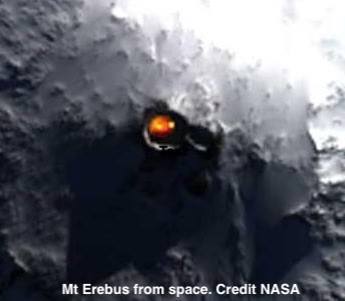
Mount Erebus, on Ross Island, is Antarctica’s highest ACTIVE volcano and site of the terrible Air New Zealand disaster in the 1970’s (see https://bit.ly/3VePfww). It was dormant for a long time but then showed increased activity from the mid-1970s. Its crater has been filled with lava on a number of occasions but so far has not overspilled the crater.
Erebus was erupting in 1841 when James Ross sailed by and discovered it, and it has erupted frequently since then, more than 200 times between 1986-1990 alone. Going back several thousand years there is no evidence that Erebus has large explosive eruptions.
However, Mount Erebus is still closely monitored because Antarctica’s largest station (the U.S. McMurdo Station) lies on its lower flank. It wouldn’t be the first time an Antarctic research base has been destroyed by a volcano. Between 1967–70 several violent eruptions on Deception Island (which is basically a giant volcanic caldera) destroyed the nearby British and Chilean stations.
Erebus is a rare example (there are only eight on Earth) of a volcano with a lava lake. You can see how this works in the video below.
I was camping on the ice over Christmas 2018 at Windless Bight in Antarctica in 2018. We were about 40 km from Mt Erebus. It is big and dominates the skyline to the north-west. Because the air is so clear in Antarctica it looks like it is only 5 km away which is the sort of mistake that was often made by early Antarctic explorers. Where a mountain range that seemed only a few hours walk might be as much as 300 km away.

